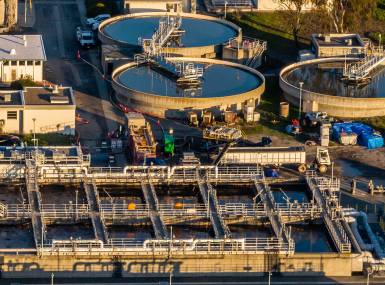Treasury Department releases guidance on how counties can access clean energy tax credits under the Inflation Reduction Act
Author

Paige Mellerio
Upcoming Events
Related News

Key Takeaways
On June 14, the U.S. Department of the Treasury (Treasury) and the Internal Revenue Service (IRS) released a proposed rule on the new elective pay mechanism established in the Inflation Reduction Act (IRA). The elective pay mechanism provides a new pathway for tax-exempt entities, including counties, to access certain clean energy tax incentives that have previously only been available to taxpayers. The proposed rule outlines how counties can choose to make an elective payment. In addition to the proposed rule on elective pay, Treasury and IRS also released a proposed rule describing how eligible taxpayers can transfer certain clean energy tax credits to unrelated parties. Comments on both proposed rules are due August 14.
Elective Pay Guidance
The IRA established an elective pay mechanism to allow tax-exempt entities, including county governments, to claim certain clean energy tax incentives. Tax incentives available to counties under elective pay include:
Clean Electricity and Reducing Carbon Emissions | Renewable Energy Production Tax Credit |
Renewable Energy Property Investment Tax Credit | |
Zero-Emission Nuclear Power Production Credit | |
Clean Electricity Production Tax Credit | |
Clean Electricity Investment Tax Credit | |
Credit for Carbon Oxide Sequestration | |
Clean Fuels | Clean Fuel Production Credit |
Clean Hydrogen Production Tax Credit | |
Clean Vehicles | Alternative Fuel Vehicle Refueling Property Credit |
Credit for Qualified Commercial Clean Vehicles | |
Clean Energy Manufacturing | Advanced Energy Project Credit |
Advanced Manufacturing Production Credit |
Counties are eligible to receive a payment directly from the federal government equal to the full value of the above credits, if all the requirements associated with the underlying credit are met. The proposed rule released by Treasury outlines how counties can receive this payment using the elective pay mechanism. Key items of note in the proposed regulations include:
- To receive a payment equal to the full value of the credit, counties must own the property or activity associated with the credit. However, ownership can take different forms including directly owning the property, owning it through a disregarded entity or owning an undivided interest in an ownership arrangement treated as tenancy-in-common.
- Local government instrumentalities, such as school districts and hospitals, are eligible to utilize the elective pay mechanism.
- Counties can combine federal grants and forgivable loans with the credits in order to finance a project.
- Counties can make an elective pay election by filing Form 990-T with the IRS by the tax return due date for the applicable tax year.
Treasury and the IRS have also published temporary regulations for an electronic pre-filing registration process that counties will need to complete in order to make an elective pay election. Through the registration process counties will need to provide the IRS with certain information, including which credit they intend to earn ad each eligible property or project that will contribute to that credit.
Transferability Guidance
The IRA allows eligible taxpayers to transfer (sell) a specified amount of certain clean energy tax credits to unrelated parties. Credits eligible for transfer by an eligible taxpayer include:
Clean Electricity and Reducing Carbon Emissions | Renewable Energy Production Tax Credit |
Renewable Energy Property Investment Tax Credit | |
Zero-Emission Nuclear Power Production Credit | |
Clean Electricity Production Tax Credit | |
Clean Electricity Investment Tax Credit | |
Credit for Carbon Oxide Sequestration | |
Clean Fuels | Clean Fuel Production Credit |
Clean Hydrogen Production Tax Credit | |
Clean Vehicles | Alternative Fuel Vehicle Refueling Property Credit |
Clean Energy Manufacturing | Advanced Energy Project Credit |
Advanced Manufacturing Production Credit |
Under the proposed rule issued by Treasury and the IRS, an eligible taxpayer is any taxpayer that is ineligible to receive an elective payment. Simply put, counties are not eligible to sell any portion of their credit/elective payment to another entity.
The proposed rule generally defines “taxpayer” as any person subject to any internal revenue tax and includes entities that have U.S. employment or excise tax liabilities if they do not have any income tax obligation. The only requirement for taxpayers to purchase or receive a transfer is that they are unrelated to the eligible taxpayer. The proposed rule clarifies that “unrelated” would mean the taxpayer is not a family member or have any business or monetary conflicts of interest. However, counties do not have to rely on purchasing or receiving a transfer of credits from eligible taxpayers as they are eligible to elect to receive direct payments equal to the value of the above credits.
NACo is analyzing the impact of the proposed elective pay and transferability rules on counties and will publish an in-depth analysis in the coming weeks.
Related Resources
- Elective Pay and Transferability Frequently Asked Questions: Elective Pay (Treasury Department)
- Elective Pay and Transferability Frequently Asked Questions: Transferability (Treasury Department)
Attachments
Related News

Congress examines PFAS liability and cleanup regulations
On December 18, the U.S. House Energy and Commerce Subcommittee on Environment held a hearing examining the current statutory and regulatory landscape for PFAS. The hearing follows a similar hearing held by the U.S. Senate Environment and Public Works Committee on November 19.
‘Fix-It Fair’ brings new life to damaged items, helps divert waste
Thurston County, Wash. partnered with a non-profit to help residents fix things that are difficult to recycle.

U.S. House of Representatives passes SPEED Act and other permitting reform bills
On December 18, the U.S. House of Representatives passed the SPEED Act (H.R. 4776). The SPEED Act would strengthen county involvement in decision-making and make needed commonsense reforms to the federal environmental review process.
